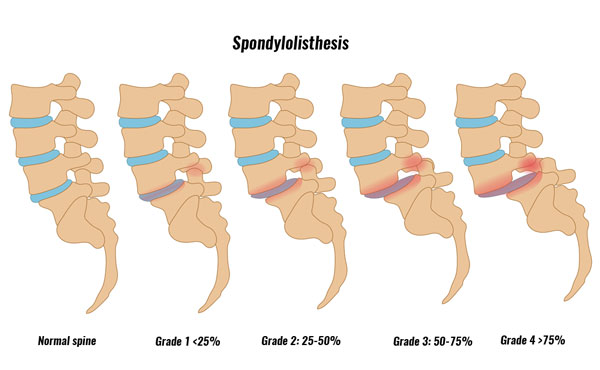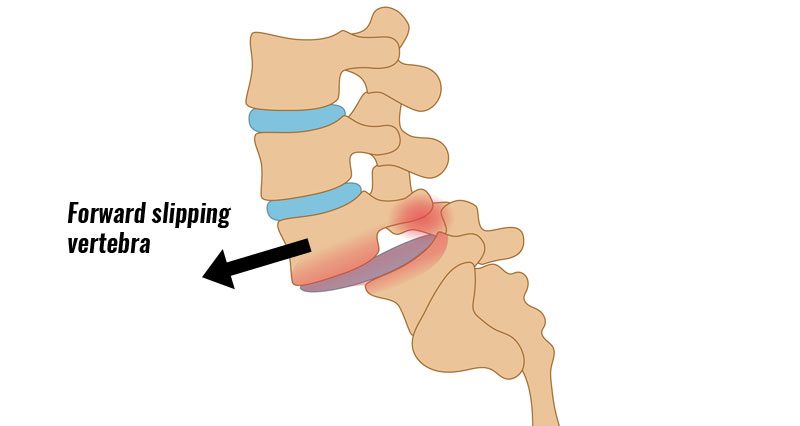Spondylolisthesis is a back injury which affects children between the ages of 9 and 14. It involves one vertebra in the spine slipping forward over another. Here we explain the symptoms, causes, and treatment of Spondylolisthesis.
Symptoms of Spondylolisthesis
Spondylolisthesis symptoms are categorized into grades 1 to 4 depending on severity.
- With grade 1 Spondylolisthesis there may be no symptoms at all and patients may be totally unaware they have a defect in the spine.
- Grade 2 Spondylolisthesis symptoms may include lower back pain, which may, or may not radiate into the legs.
- Pain is worse with activities which involve bending backwards of the spine.
- It may be possible to feel a dip in the spine at the point where the vertebrae slip forwards.
- An X-ray in a position that triggers the pain can confirm the diagnosis.
What is Spondylolisthesis?

Spondylolisthesis is a back injury involving a forward slipping of one vertebra over another and is most commonly seen in children between the ages of 9 and 14. It is also more common in sports that have a lot of strain on the back, for example, throwing events, wrestling, weight lifting, and gymnastics. The risk of slipping forward in people over the age of twenty-five is very small. It is usually the fifth or bottom lumbar vertebrae (L5) which slip forward over the top sacrum bone (S1).
It is often seen in conjunction with a stress fracture of the pars interarticularis (Spondylolysis). Most cases of pars interarticularis defects associated with spondylolysis are those where there is a family history of the defect. Stress fractures of the pars interarticularis through overuse are rarely thought to cause spondylolisthesis.
Spondylolisthesis is graded depending on how far forward the vertebra has slipped. It is measured by X-ray from the side and graded as follows:
- 1 – 25% forward movement
- 2 – greater than 25% forward movement.
- 3 – greater than 50% forward movement.
- 4 – greater than 75% forward movement.
Treatment of Spondylolisthesis
What can the athlete do?
- Rest from activities which cause or make the pain worse.
- The athlete may be able to continue training but avoid exercises that stress the back.
- Stretch the hamstring muscles as tight hamstring muscles may rotate the pelvis backwards in relation to the forward slipping vertebra.
- Do abdominal and core strengthening exercises.
- Wear a back brace or back support to prevent the lower spine from bending forward too much (anti-lordotic).
- See a sports injury specialist or doctor.
What can a sports injury specialist or doctor do?
- Prescribe strengthening exercises.
- Gently mobilize stiff joints in the spine around the forward slipping joint (but manipulation should not be done at the joint itself).
- Operate if another treatment is not successful.
When can I return to sports?
- Grade 1 and 2 patients can return as soon as they are pain-free and have good core strength.
- Grade 3 and 4 patients should avoid contact sports or sports involving high speed and changes of direction.
Spondylolisthesis does not usually get worse, but if the amount of slipping increases then a surgeon may operate to fuse the bones together preventing further forward slipping.
References & further reading
- Andrade N, Ashton C, Wray N et al. Systematic review of observational studies reveals no association between low back pain and lumbar spondylolysis with or without isthmic spondylolisthesis. Eur Spine J 2015;24:1289–95.








